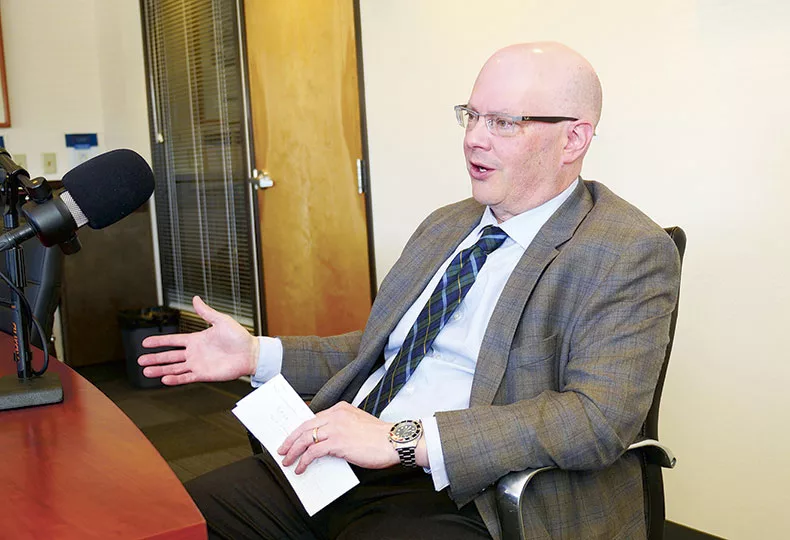
Home » Five Takeaways: Mid-Year Economic Outlook with Avista Corp. Chief Economist Grant Forsyth
Five Takeaways: Mid-Year Economic Outlook with Avista Corp. Chief Economist Grant Forsyth

June 6, 2024
The Journal of Business hosted Grant Forsyth, chief economist for Avista Corp., for its most recent Elevating The Conversation podcast.
The Elevating The Conversation podcast is available on Apple Podcasts, Amazon Music, Spotify, and elsewhere. Search for it on any of those platforms or the Journal's website to hear the entire conversation, but for now, here are five takeaways from the episode, which runs just under 40 minutes.
1. Don't expect interest rate relief this year. The markets are now moving toward only one rate cut this year, toward the end. Goods prices have moderated a lot. In fact, we're seeing a little bit of deflation there. But because of that stickiness and services, a lot of people think the Federal Reserve is going to be lucky to get one rate decrease this year.
That's in contrast to what we thought at the beginning of the year, which was something more along the lines of three or four rating decreases. It's completely changed because, again, the inflation picture has been stickier than people expected. That's causing people to realize that lining up closer with the Fed's forward guidance is the right thing to do. The markets are becoming maybe even a little more conservative than that and thinking if they get one rate cut in, we'll be lucky again.
At the small business or at the main street level, I don't think you're going to get any interest rate relief this year. The reality is, you're looking at maybe a little bit of relief going into 2025, unless there's some important change in inflation or we see inflation moderate faster than people currently expect. That would require service prices to moderate faster than what we've seen.
2. Services are driving inflation more than goods. Services are really dominated by what they call shelter cost, which is housing costs. The Fed raised rates, and it did slow housing activity, but we really haven't seen a big decline in home prices. That's certainly the case in our region, and it's certainly the case in a lot of other markets in the United States. You did see some of the bigger markets that were really inflated have more of a price change, but generally, home prices and rental prices have stayed in there, even with the higher rates.
What's driving that, though, is that we just have supply restrictions. We underbuilt following the housing bubble, and that's continuing to keep the supply constrained, which keeps prices from falling very much.
The other thing that's probably affecting housing is that you have a whole bunch of people with really low interest rates that probably will never be replicated again. It's really hard to give up that interest rate on your current house and move into a new house that's probably going to have a higher rate. That's also restricting the homes that are available for sale.
So shelter costs are a big part of that, but It's not the only thing that's affecting services. It doesn't get reported on as much, but if you look in detail at the Bureau of Labor Statistics data, you see the price of hospital services is rising. That includes veterinary services. Motor vehicle repair has got a pretty good inflation rate.
And there's insurance costs, and not just insurance costs on cars. We can expect some further price shocks on the insurance side for structures all through the U.S. because of increasing climate change and extreme weather events. Insurance cost are an issue. We're not done with that yet.
3. The job market has remained surprisingly strong. If you look at the Spokane-Kootenai market combined, we're up probably over 3% In terms of job growth in the first quarter, compared to the first quarter last year, in total employment. That's very strong when you compare that against the U.S., which has been at about 1.8% job growth.
This is much stronger than I would have expected. When I gave the forecast to Greater Spokane Incorporated in November, I expected us to be under 2% employment growth this year because we had just over 2% growth in 2023. But the job market continues to be pretty strong, stronger than I think most people expected, and it's pretty broad-based growth, across sectors.
It is stronger on the Idaho side. Again, looking at first quarter last year to first quarter this year, growth is in excess of 4% It's pretty strong. Part of that may reflect some differences in policies between the two states.
4. Recession isn't imminent, but risks remain. I was definitely in the recession camp when the fed was raising rates last year. I predicted we would have one in 2023. I thought it would be very mild. It would be a short and shallow, as we say. And it didn't materialize.
The economy surprised everybody in its ability to absorb what was a pretty rapid rise in interest rates, certainly more rapid than a lot of younger professional people or households would have been used to.
I will say, though, there are risks. This is the thing that's really important to talk about. Domestic risks of a recession have receded. What I worry about are what I call geopolitical risks, and I'm not alone in this.
I've been worried about this since pre-pandemic, because what you're seeing is a post World War II order that's falling apart. There are real risks to conflicts blowing up to a size and proportion that disrupts global economic activity.
We can see the tensions between the Philippines and China. We can see the tensions between Europe and Russia over the Ukraine. We can see all kinds of tensions in the Middle East. There are real risks there. We also have an election coming up in the United States that's going to be highly contentious again.
5. Moving forward, think twice before making cuts. You've worked really hard to get back to operating after the pandemic. You've probably struggled really hard to get employees. It's one of the hardest things a business can do. Don't be in a rush to lay your workers off until you're really sure that it's necessary. It was so hard to get them in the first place.
It's a message that we've sent before about really looking more at what you see in your own business than what you're reading about outside of your business.
Just don't panic and don't start cutting jobs. Because again, it's just so hard to operate now in the labor market to bring in people, and wages are much higher. You're having to spend more to bring that labor in. And once you get those workers in and they're working out, you don't want to let them go on a whim.
Latest News Banking & Finance Insights
Related Articles
Related Products



_web.webp?t=1758783848)
_web.webp?t=1757574393)